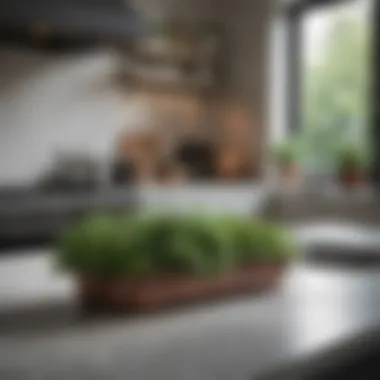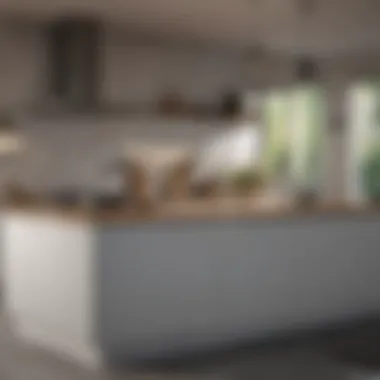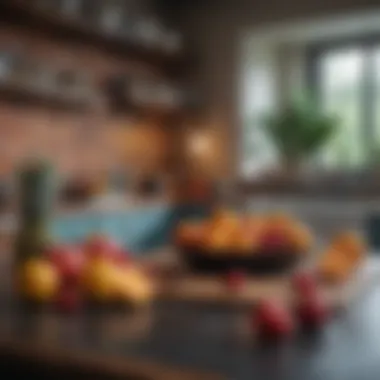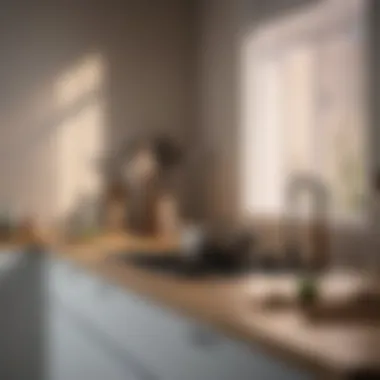Elevate Your Kitchen: Top Decor Ideas & Trends


Intro
The kitchen is often considered the heart of the home, serving not only as a place for cooking but also as a space for gathering. In this environment, the decor on top surfaces plays a crucial role. Kitchen top decor encompasses the items and arrangements that adorn countertops, islands, and tables. It can greatly influence the overall aesthetic and functionality of the kitchen by showcasing personal style while maintaining practicality.
As homeowners increasingly recognize the potential of kitchen design, it becomes essential to understand current trends and timeless principles. This article aims to provide a comprehensive exploration into kitchen top decor, discussing design principles, material choices, and practical applications. By addressing various preferences and lifestyles, we can aid both new homeowners and seasoned decorators in crafting a pleasing and efficient kitchen space.
Key Insights and Trends
Current trends in interior design
Interior design trends frequently shift, reflecting societal changes and aesthetic preferences. Some prominent trends currently shaping kitchen top decor include:
- Minimalism: Clean lines and uncluttered surfaces are favored. The emphasis is on fewer items that serve a purpose and contribute to the overall design.
- Natural materials: Wood, stone, and ceramics are increasingly used, both for durability and beauty. They bring warmth and a sense of nature indoors.
- Color palettes: Soft, muted colors dominate the scene. These colors create a calm atmosphere, enhancing the inviting nature of the kitchen.
- Functionality meets style: More homeowners are prioritizing functional pieces that also offer visual appeal. This can include decorative canisters or aesthetically pleasing cutting boards.
Popular gardening techniques of the season
Plant decor is also relevant within kitchen environments. Utilizing plants adds an organic touch and can improve air quality. Some favored techniques include:
- Herb gardening: Growing herbs like basil and parsley on kitchen counters not only offers fresh ingredients but also acts as lively decor.
- Vertical gardening: When space is limited, vertical gardens allow for creativity while saving valuable countertop space.
- Succulents and air plants: These are low-maintenance options that can flourish in sunlight or indirect light, making them suitable for kitchen decor.
"The right kitchen top decor can transform an ordinary space into a culinary sanctuary."
Practical Tips and How-To Guides
Step-by-step guides for home decoration projects
Creating an appealing kitchen top decor can feel daunting. Here’s a simple guide:
- Declutter: Remove all items from your counters. Decide what must stay for functionality.
- Choose a theme: Select a color scheme or material focus.
- Incorporate functional items: Consider stylish storage solutions for utensils or cutting boards that align with your theme.
- Add decorative accents: Introduce elements such as candles, bowls, or artwork that resonate with your chosen theme.
- Decorate with plants: Position herbs or small potted plants in strategic areas to enhance aesthetics and create a welcoming feel.
Entertaining tips and planning checklists
When hosting, the kitchen often becomes the gathering point. To prepare efficiently:
- Clean and organize countertops. This provides a welcoming environment.
- Create a beverage station: Sum up essentials like glasses, cocktail mixers, or coffee, depending on the occasion.
- Arrange snacks appealingly: A visually appealing display can dictate the atmosphere, so consider cheeseboards or tiered trays.
In closing, the exploration of kitchen top decor reveals its significance in enhancing both function and style. From understanding trends to practical application, the choices made reflect not just aesthetic preference but also personal lifestyle, paving the way for kitchens that are both beautiful and livable.
Understanding Kitchen Top Decor
Kitchen top decor has become a vital aspect of home design, precisely because it blends aesthetics with functionality. Homeowners, interior design enthusiasts, and anyone who frequently uses the kitchen understand that this space is not merely utilitarian but also a canvas for creativity. Though often overlooked, the top surfaces in kitchens serve as focal points in decorating schemes and should be thoughtfully considered.
Defining Kitchen Top Decor
Defining kitchen top decor extends beyond mere aesthetics; it encompasses a wide range of elements. It includes countertop materials, decorative items, and the overall arrangement of kitchen appliances. The decor can be influenced by various styles—from minimalist to rustic. A well-defined kitchen top decor showcases personal style while also catering to the practical needs of daily cooking and preparation. In simpler terms, it is the art and science of making these surfaces both appealing and useful.
Importance of Functional Aesthetics
The significance of functional aesthetics in kitchen top decor cannot be understated. Functional aesthetics refers to the marriage of beauty and usability. Homeowners desire spaces that are not only attractive but also serve a purpose. This duality can enhance the overall experience in the kitchen. The decor can elevate functions like food preparation, cooking, and storage while ensuring an enjoyable atmosphere.
"A kitchen that looks good can elevate the entire cooking experience, making it feel less like a chore and more like an enjoyable activity."
Aesthetics contribute to creating a welcoming vibe, which is crucial for entertaining guests as well. The choice of colors, materials, and items all contribute to how the space feels. In sum, striking a balance between utility and design can lead to remarkable kitchen spaces that inspire creativity and efficiency.
Key Elements of Kitchen Top Decor
Understanding the key elements of kitchen top decor is essential for achieving a balance between aesthetics and functionality. The kitchen is a dynamic space that often serves multiple purposes. Having well-thought-out decor can enhance not only the appearance of the kitchen but also its usability. A well-decorated kitchen countertop can reflect personal style while promoting efficient organization and functionality.
Color Schemes
Color schemes play a fundamental role in setting the mood and style of the kitchen. Choosing an appropriate color palette can dictate the overall vibe.
Monochromatic Approaches
Monochromatic approaches utilize variations of a single color. This style can create a cohesive and sophisticated look. The key characteristic is its simplicity. It allows homeowners to introduce different textures and materials without overwhelming the senses. A benefit of this approach is that it can make a small kitchen appear larger by using light shades. However, a disadvantage might be that it can come off as bland if not complemented with sufficient variety in textures or shapes.
Contrasting Colors


Contrasting colors involve pairing colors from opposite ends of the color wheel. This can create a vibrant and energetic atmosphere. The key characteristic is the stark difference that attracts attention. It can make decorative items stand out, acting as focal points. The advantage of this method is its ability to introduce drama and depth. On the flip side, it may require a more careful selection to avoid visual chaos or clash.
Nature-Inspired Palettes
Nature-inspired palettes draw from earthy, organic colors found in nature. This style offers warmth and tranquility. The key characteristic is its relatable and soothing color combinations, such as greens, browns, and blues. It is a popular choice because it promotes a calming space, ideal for cooking and gathering. However, it may limit the impact if the colors are too muted or not balanced well against other decor elements.
Materials and Textures
The choice of materials and textures is critical in giving physical and visual substance to the kitchen decor. Different materials can evoke different feelings and practicality.
Natural Materials
Natural materials, like wood and stone, bring an organic feel to the kitchen. Their key characteristic is their connection to nature, which adds warmth and authenticity. This choice is beneficial as it enhances durability and can age gracefully over time. A potential disadvantage is the maintenance, as some natural materials may require more care to keep them looking their best.
Man-Made Surfaces
Man-made surfaces include products like quartz and laminate. They offer a variety of colors and finishes. Their key characteristics are consistency and ease of maintenance. These surfaces can mimic the look of natural materials, making them versatile and practical. A benefit is affordability and the broad range of styles. However, they might lack the unique character that natural materials present, which some homeowners may find unappealing.
Textural Layering
Textural layering refers to combining different textures to create a multidimensional look. The key characteristic is the visual interest that it adds to the space. It can enhance both aesthetic and tactile appeal. This method is beneficial because it allows flexibility in combining various styles and materials. However, over-layering can create clutter, making the area look disorganized.
Functional Accessories
Functional accessories are not just decorative but also serve specific purposes. The right accessories can improve kitchen efficiency while enhancing style.
Storage Solutions
Storage solutions are crucial in maintaining organization on kitchen tops. They can take the form of racks, bins, or drawers. Their key characteristic is maximizing space without compromising style. This choice is beneficial as it helps keep counters clear. The downside might be if the storage solutions are not aesthetically pleasing, which can detract from the overall decor.
Cooking Utensils Display
Displaying cooking utensils can bring a homely feel to the kitchen. Tools such as spatulas and ladles can be arranged in jars or hung on a rod. The key characteristic is that they serve a decorative purpose while remaining accessible. This choice can provide a personal touch to the kitchen. However, if not organized, it can lead to visual clutter, which many might find unappealing.
Decorative Containers
Decorative containers serve dual functions; they hold items and add style. These containers can be used for storing grains, spices, or snacks. Their key characteristic is versatility, allowing them to fit various decor styles. This choice adds a pop of style while maintaining organization. A potential drawback is that if they are not kept tidy, they can detract from an otherwise clean look.
Trends in Kitchen Top Decor
Trends in kitchen top decor reflect the evolving tastes and preferences of homeowners. Understanding these trends is crucial for anyone aiming to create a functional and aesthetic kitchen space. Trends often reveal shifts in lifestyle, environmental consciousness, and technological advances. Recognizing these elements can help homeowners make informed choices in their decor and design approaches. This section explores three prominent trends that are shaping kitchen top decor today.
Minimalist Designs
Minimalist designs emphasize simplicity and uncluttered spaces. This trend encourages homeowners to focus on essential elements and reduce excess. The beauty of minimalism lies in its ability to create an open and airy environment, fostering a feeling of tranquility. Using a few well-chosen decor items can enhance visual appeal without overwhelming the senses. Key features of minimalist kitchen tops include neutral color palettes, sleek lines, and high-quality materials.
Some benefits of adopting a minimalist design include easier cleaning and maintenance, as well as a more organized workspace. When fewer items occupy the kitchen top, it becomes easier to curate an inviting and practical environment for cooking and entertaining.
Eco-Friendly Choices
The move towards sustainability is gaining momentum in kitchen decor. Eco-friendly choices advocate for the use of sustainable materials and practices that minimize environmental impact. This trend encourages homeowners to source materials from renewable resources, such as bamboo or recycled glass. The use of organic textiles for kitchen accessories also complements this movement.
Investing in eco-friendly kitchen decor can foster a sense of responsibility towards the environment. Benefits of this trend include reduced carbon footprint and improved air quality within the home. Moreover, embracing natural elements often results in a warmer and more inviting atmosphere, aligning with the growing desire for eco-conscious living. Many homeowners are now looking for decor that aligns with their values and contributes positively to the planet.
Vintage and Retro Styles
Vintage and retro styles are making a strong comeback in kitchen decor. This trend pays homage to past design eras while incorporating modern functionality. Utilizing vintage items can add character and charm to kitchen tops. Homeowners often seek unique pieces, such as antique utensils or retro canisters, which can tell a story and spark conversations.
Mixing old and new elements enhances visual interest and creates a distinct personal style. The appeal of vintage decor lies in its ability to blend memories with present realities, offering a sense of nostalgia. Choosing vintage items also supports sustainable practices by encouraging the reuse of materials. Embracing this trend allows individuals to express creativity while enjoying a piece of history in their kitchen spaces.
Embracing trends in kitchen top decor allows for personal expression while considering aesthetics and functionality.
In summary, staying abreast of trends in kitchen top decor can significantly influence design choices. Whether opting for minimalist, eco-friendly, or vintage styles, each trend presents unique benefits and considerations for homeowners. Understanding these trends can lead to a well-decorated kitchen that reflects personal taste and enhances daily activities.
Practical Tips for Styling Kitchen Tops
Effective styling is crucial in achieving an inviting and practical kitchen top space. Kitchen tops often serve dual roles: they are not just functional areas for food preparation and cooking but also visible parts of the home that contribute to overall aesthetic. With careful styling, homeowners can create spaces that are both pleasing to the eye and efficient for day-to-day tasks. The balance of decor and functionality can transform the kitchen from mundane to extraordinary.
Decluttering Strategies


Decluttering is the first step in styling kitchen tops effectively. A cluttered space can feel chaotic, detracting from its potential beauty.
- Regularly assess items on the kitchen top and remove anything that doesn't belong or is rarely used.
- Utilize drawer and cabinet space for storage to keep excessive items out of sight.
- Consider using trays or baskets to collect smaller items, which can also add to the decorative aspect.
Keeping surfaces tidy will enhance both the functionality and visual appeal of the kitchen.
Arranging Decorative Items
Arranging decorative items has a significant impact on the overall visual expression of the kitchen top. Proper arrangement adds layers and interest to the space.
Height Variation
Height variation provides depth in design. Incorporating items of varied heights can create focal points that draw the eye.
- Use tall vases alongside shorter bowls or containers.
- Stacking books or display stands can also create height differences.
This approach breaks monotony and adds visual interest to kitchen tops, making them more engaging.
Grouping Similar Items
Grouping similar items offers a sense of cohesion.
- Choose a theme or color palette for your decorative items.
- Arrange items in clusters rather than spreading them out.
Similar pieces can create a unified look and help achieve balance throughout the kitchen space. This not only helps in styling but also makes cleaning easier.
Balance and Symmetry
Balance and symmetry are fundamental principles in design.
- Aim for an even distribution of visual weight through the arrangement of items.
- You can achieve this with either symmetrical arrangements or asymmetrical arrangements with equal visual weight.
Creating balance ensures that the kitchen top looks intentional and well-appointed, which can elevate its overall design.
Incorporating Plants
Adding plants introduces life and freshness to the kitchen top. They can enhance the aesthetic while providing practical benefits like improving air quality.
Choosing the Right Plants
Choosing the right plants is essential for maintaining a vibrant kitchen atmosphere.
- Opt for easy-to-care-for plants like succulents or herbs.
- Consider the light conditions of your kitchen; some plants thrive in bright light while others prefer indirect light.
Selecting suitable plants will ensure they flourish and enhance the kitchen's charm without demanding excessive maintenance.
Placement Ideas
Placement can significantly affect the overall impact of plants in your kitchen.
- Position plants near natural light or on window sills for optimal growth.
- Use varying heights by placing some pots on stands or shelves.
This can lead to an engaging display that benefits both the aesthetics and the plants' health.
Maintenance Tips
Regular maintenance is vital to keep plants thriving.
- Watering frequency depends on the plant type; ensure to do some research on care.
- Clean the leaves of dust to allow for maximum light absorption.
Setting a care schedule keeps plants looking pristine, ultimately enhancing the kitchen's visual environment.
Creating a well-styled kitchen top requires attention to detail and a balance between aesthetics and functionality. It should reflect taste and provide effective use of space.
Common Mistakes to Avoid
When decorating kitchen tops, it is easy to overlook significant aspects that can affect both aesthetics and functionality. Understanding common mistakes helps homeowners avoid frustration and enhance their kitchen experience. This section will explore three prevalent mistakes: overcrowding the space, neglecting functionality, and ignoring lighting needs. Each error can lead to a less effective design and reduce the overall enjoyment of the kitchen.
Overcrowding the Space
Overcrowding is one of the most frequent issues people face in kitchen decor. A cluttered top can create a chaotic feel, making the space less inviting. Items packed tightly together prevent functionality and limit usability. For instance, if all available counter space is filled with appliances, it may become challenging to prepare meals or clean the area efficiently.
To avoid overcrowding, consider the following:
- Declutter regularly: Removing unnecessary items keeps the space organized.
- Limit decorative pieces: Choose a few standout items instead of overwhelming the surface with many smaller objects.
- Use vertical space: Mounting shelves can help store items off the counter, easing visual clutter without sacrificing accessibility.
Neglecting Functionality
Functionality is paramount in any kitchen space. When decor choices lean heavily on aesthetics at the expense of practicality, it can diminish the overall experience. For example, getting carried away with decorative elements, like intricate sculptures or fragile items, might render the kitchen less appealing for daily use.
To prioritize functionality:
- Identify daily needs: Keep essential tools within arm's reach, such as knives or cutting boards.
- Consider versatile pieces: Opt for decor that serves more than one purpose. For instance, a decorative bowl can be both an art piece and a storage solution for fruits or utensils.
- Design for ease of cleaning: Clutter-free surfaces make maintaining a clean kitchen easier. Avoid complex arrangements that gather dust and dirt.


Ignoring Lighting Needs
Lighting plays a crucial role in the kitchen, affecting both ambiance and functionality. Inadequate lighting can make a beautifully decorated surface look dull and unwelcoming. Moreover, poor visibility makes food preparation and cooking a challenge.
Addressing lighting effectively involves:
- Layering lights: Use a combination of overhead lights and task lights to illuminate work areas.
- Choosing warm color temperatures: This creates a more inviting atmosphere, softening starkness often present in kitchens.
- Positioning lights strategically: Ensure that areas like the cooking space, and counters are well-lit to facilitate daily tasks.
Effective kitchen decor is a blend of style and function. Understanding and avoiding common mistakes ensures your kitchen remains a joyful and practical space.
Personalizing Your Kitchen Top Decor
Personalizing kitchen top decor is a crucial aspect of creating a space that feels uniquely yours. It is not just about aesthetics; it also reflects your personality, interests, and lifestyle. Individual expression in this area can transform a standard kitchen into a welcoming hub that truly embodies who you are. Personalization can lead to emotional connections with your space, enhancing not just the look but also the feel of the kitchen.
When creating a personalized decor, consider the balance between style and functionality. Each piece should serve a purpose while contributing to the overall aesthetics. The choices you make can make cooking more enjoyable, hosting more appealing, and daily living enriched with visual comfort.
Showcasing Personal Collections
Showcasing personal collections on kitchen tops adds character. Everyone has items of significance—be it beautiful crockery inherited from family, unique spices from travels, or handmade utensils. These pieces can create focal points that draw the eye and offer conversation starters. They can also tell a story, providing a glimpse into your personal history and experiences.
Here are some tips for displaying collections effectively:
- Group Similar Items: This helps to create a cohesive look. For instance, group patterned plates together or arrange wooden utensils in a decorative jar.
- Use Varying Heights: Introducing items of different heights creates visual interest. Place smaller items in front of larger ones, or use risers.
- Rotate Items: Change items periodically to keep the space fresh. This not only reduces monotony but also allows you to enjoy your collections fully.
Cultural Influences in Design
Cultural influences play a significant role in kitchen decor. Every culture has unique traditions and aesthetics, which can enrich your kitchen design. Whether you want to infuse elements from the Mediterranean, Asian, or Latin American styles, each cultural influence offers distinct features that enhance personalization.
When incorporating cultural design elements, consider:
- Color Choices: Different cultures favor specific colors that can influence mood. For example, vibrant reds and oranges might reflect an Indian influence, while shades of blue and white may evoke a Greek ambiance.
- Symbols and Artifacts: Use cultural symbols, such as pottery or textiles, that represent your heritage. This can bring a sense of home and nostalgia to your kitchen.
- Culinary Traditions: Showcase your love for your culture by displaying traditional cooking tools or ingredients specific to your heritage. It enriches the environment and reinforces cultural pride.
Personalization of kitchen tops is not merely about decor. It is about expressing individuality and creating emotional connections with your space.
By thoughtfully curating your kitchen decor, you can craft an environment that is not only visually appealing but also deeply meaningful.
Future Trends and Innovations in Kitchen Decor
As the heart of the home, the kitchen is evolving beyond mere functionality. Future trends in kitchen decor focus on how innovative solutions will shape our kitchen spaces. These trends emphasize convenience, sustainability, and aesthetic appeal, providing homeowners with a cohesive design that caters to modern needs. The incorporation of advanced technologies alongside eco-friendly materials demonstrates a shift toward not just style, but also enhanced functionality.
Smart Technology Integration
Smart technology is revolutionizing kitchen experiences. Homeowners now prioritize integration features that allow for seamless control of appliances. Devices like smart refrigerators that can suggest recipes based on available ingredients or ovens that can be controlled through mobile apps enhance convenience.
Furthermore, smart lighting solutions can adapt to different tasks, whether it's brightening for meal prep or dimming for evening ambiance. These technologies not only augment daily tasks but can also lead to energy-efficiency—a crucial aspect for many.
"Smart kitchens combine functionality with innovation, making cooking a more enjoyable experience."
Integrating smart technology involves considering several factors:
- Compatibility: Ensure devices communicate with each other and with existing smart home systems.
- User-Friendly Interfaces: Look for appliances that provide intuitive controls.
- Energy Efficiency: Choose smart devices that monitor energy consumption to reduce utility bills.
Sustainable Materials
The shift towards sustainability is a core trend in kitchen decor. Homeowners are increasingly conscious about the materials they choose. Sustainability does not only benefit the environment but can also enhance the overall aesthetic of a kitchen.
Materials like bamboo, recycled metals, and reclaimed wood offer durability without compromising style. For example, bamboo is not just visually appealing; it thrives with minimal resources, making it an excellent choice for eco-conscious designers.
When selecting sustainable materials, consider:
- Source: Understand where the materials come from and their environmental impact.
- Durability: Opt for materials that will stand the test of time, reducing the need for frequent replacements.
- Aesthetic Versatility: Look for options that can blend well with various color schemes and design themes.
Innovative manufacturers are also introducing biodegradable and non-toxic materials, meeting both environmental and health standards. The rise of these options allows for creative freedom while making responsible choices.
Epilogue: The Essence of Kitchen Top Decor
The domain of kitchen top decor encapsulates more than aesthetic appeal; it embodies a blend of personal expression and practical form. In this article, the significance of kitchen top decor has been examined through various lenses. One must consider that the kitchen often serves as the heart of the home. Hence, the decor choices made in this space can resonate deeply with both function and style. The choices made in terms of color schemes, materials, and decorative items contribute not only to the visual harmony of the home but also define its functionality.
Reflecting on style and function, it becomes evident that kitchen top decor is an essential element in creating an efficient workspace. Appropriate design fosters a seamless cooking experience, integrating beauty with usability. Each item on the countertop, whether a stylish fruit bowl or a visually appealing spice rack, contributes to the overall atmosphere of the kitchen. Homeowners must find a balance between showcasing personal flair and ensuring that the decor enhances rather than hinders efficiency.
"A beautifully styled kitchen can foster creativity and joy, turning mundane tasks into pleasurable activities."
Encouragement for continuous exploration in kitchen top decor emphasizes the evolution of this resting space. Trends shift, and materials change, contributing to new ways of engaging with kitchen environments. Homeowners are encouraged to continuously experiment with arrangements, materials, and accessories, ensuring that their kitchen reflects their evolving tastes and lifestyle needs. Exploring emerging styles, such as sustainable materials or smart technology, keeps the kitchen relevant and appealing.
By synthesizing these concepts, one draws a conclusive statement: kitchen top decor is fundamentally about the intersection of practicality and personal expression. Each kitchen can become a unique canvas, allowing homeowners to assert their personal narrative through decor choices. Listing potential directions for future exploration can involve keeping abreast of new trends, understanding how to incorporate smart technology, or delving into the world of sustainable materials. As this journey in kitchen decor continues, it allows a delightful narrative to unfold, enhancing the cooking space and transforming it into an inviting sanctuary.



